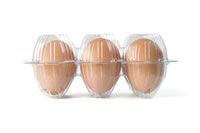While consumers place increasing emphasis on attractive visual presentation of food and, therefore, on transparent packaging, production of such packaging needs to remain cost-effective. Modern packaging also requires the physical and chemical properties to withstand transportation and storage. These many requirements can be met by using Styrolux or Styrolux blends.
Processing advantages
Cost benefits are ensured through favourable inherent processing parameters – Styrolux can be processed without pre-drying on general extrusion, injection moulding and thermoforming machinery.
High output rates in extrusion, fast cycles in injection moulding and exceptionally good formability ensure high productivity, while low density in comparison to other transparent materials (such as polyester) also contributes to cost efficiency, balancing the initially higher material cost of Styrolux.
Products manufactured from Styrolux and Styrolux blends can be decorated, welded and adhesive bonded following manufacturing; and integral hinges and snap-fit joints can be integrated into any moulded part. Sterilisation with high-energy radiation or ethylene oxide is yet another valuable attribute.
The blend most frequently encountered is that of Styrolux and general-purpose styrene (GPPS). With application-specific blends, it’s possible to obtain the optimum ratio of rigidity to toughness.
Blending with GPPS not only enables specific material properties to be achieved, but also reduces moulding costs. In these blends, polystyrene imparts rigidity and increases heat deflection temperature, while Styrolux adds toughness to the final product.
Optical, mechanical, thermal properties
The transparency of blends made from Styrolux and GPPS depends on the grades used, the blending ratio and the homogeneity of the blend. The blending ratio of Styrolux to GPPS affects both transparency and haze and the desired ratio is easily calculated from relative transmission data.
Although toughness increases with oil-containing grades at the same blending ratio, transparency is reduced. Styrolux grades of outstanding transparency and low haze are available to provide superior optical properties.
Good mixing performance is an important precondition for the production of high-quality sheet and highly-transparent injection moulded articles without flow streaks.
With an increasing GPPS content, the stiffness of blends increases almost linearly across all grades. This is particularly beneficial in extrusion applications. In contrast to stiffness, the toughness of Styrolux/GPPS blends reduces in relation to the GPPS addition percentage. Puncture resistance reduces with increasing GPPS content and oil-containing GPPS grades ensure higher toughness. GPPS grades containing lubricant give higher toughness values than oil-free grades at similar bending ratios while sheet toughness can be further increased by using a lubricant-modified high molecular weight grade of GPPS. Styrolux grades of high stiffness require a lower addition ratio to GPPS, improving cost efficiency without compromising tensile properties.
Heat resistance of Styrolux/GPPS blends shows a linear increase with GPPS content. A specific stabiliser system gives Styrolux excellent thermal stability and a very low fish-eye level.
The market for transparent packaging materials is increasingly competitive, with materials such as PET, PVC, polyolefins and polystyrene competing for market share. With its customisable properties, Styrolux and Styrolux/GPPS blends are closing the gap between costly transparent engineering plastics and standard polystyrene.










